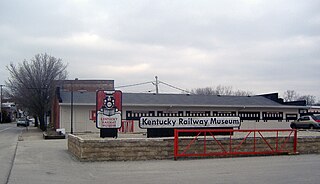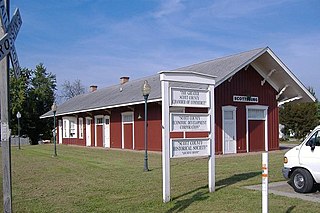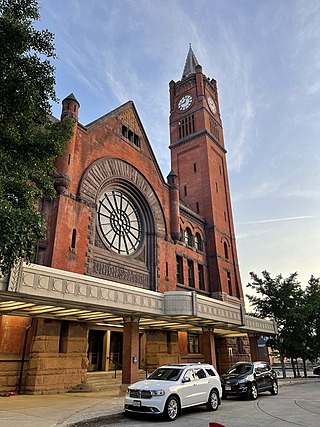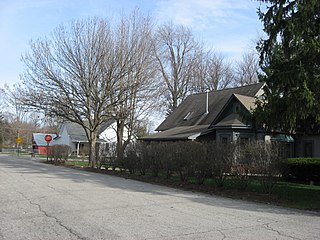
Linden is a town in Madison Township, Montgomery County, in the U.S. state of Indiana. The population was 711 at the 2020 census.

The Monon Railroad, also known as the Chicago, Indianapolis, and Louisville Railway from 1897 to 1971, was an American railroad that operated almost entirely within the state of Indiana. The Monon was merged into the Louisville and Nashville Railroad in 1971, and much of the former Monon right of way is owned today by CSX Transportation. In 1970, it operated 540 miles (870 km) of road on 792 miles (1,275 km) of track; that year it reported 1320 million ton-miles of revenue freight and zero passenger-miles.
The Jeffersonville, Madison and Indianapolis Railroad (JM&I) was formed in 1866 as a merger between the Indianapolis and Madison Railroad and the Jeffersonville Railroad.

The Kentucky Railway Museum, now located in New Haven, Kentucky, United States, is a non-profit railroad museum dedicated to educating the public regarding the history and heritage of Kentucky's railroads and the people who built them. Originally created in 1954 in Louisville, Kentucky, the museum is at its third location, in extreme southern Nelson County. It is one of the oldest railroad stations in the United States.

Scottsburg is a historic railroad depot located at Scottsburg, Scott County, Indiana. It was built in 1872 by the Jeffersonville, Madison and Indianapolis Railroad, costing almost $1,492. It is a one-story, Stick Style frame building with board and batten siding and a projecting agent's window. Its presence influenced the location of Scottsburg in 1874, as the town was named for the railroad's General Superintendent, Horace Scott. It was built specifically for both passenger and freight cargo. Inside there was separate waiting rooms for men and women. Passenger service to the station ended in the 1950s. It is one of the last structures of its kind still standing in Indiana.

The John Hay Center is on the eastern edge of the Salem Downtown Historic District in Salem, Indiana. It comprises:

The Indianapolis Union Station is an intercity train station in the Wholesale District of Indianapolis, Indiana. The terminal is served by Amtrak's Cardinal line, passing through Indianapolis three times weekly.

Lafayette station is an Amtrak station in Lafayette, Indiana, served by the Cardinal. The current station facility was established in 1994. The Amtrak train previously stopped in the middle of the city's 5th Street, near the former Monon Railroad depot. The station building was moved to its current location from the southeast corner of 2nd and South streets. It is a Romanesque Revival style depot built in 1902 by the Lake Erie and Western Railroad and Cleveland, Cincinnati, Chicago and St. Louis Railway, as the Big Four Depot. The station was listed on the National Register of Historic Places in 2003.

The Cincinnati, Richmond & Muncie Depot is a restored train station in Muncie, Indiana, United States. Built in 1901, it was acquired by the Chesapeake and Ohio Railway in 1910. The station was used for passenger train service throughout the 20th century and was added to the National Register of Historic Places in 1997. It is currently used as a visitor center and office for the adjacent Cardinal Greenway.

Beverly Shores is a train station in Beverly Shores, Indiana, served by the South Shore Line interurban commuter railroad. The station serves the town of Beverly Shores as well as the nearby Town of Pines. It is a flag stop.

This is a list of the National Register of Historic Places listings in Lake County, Minnesota. It is intended to be a complete list of the properties and districts on the National Register of Historic Places in Lake County, Minnesota, United States. The locations of National Register properties and districts for which the latitude and longitude coordinates are included below, may be seen in an online map.

Hobart, also known as The Pennsy Depot, is a disused train station in Hobart, Indiana. It was built in 1911 and listed on the National Register of Historic Places in 1984 as the Pennsylvania Railroad Station.

The Bloomington freight station is a historic train station in downtown Bloomington, Indiana, United States. Constructed in the early twentieth century, it has endured closure and a series of modifications to survive to the present day, and it has been declared a historic site. Used only occasionally for many years, it is one of the most important buildings in a large historic district on the city's west side.

Centennial Neighborhood District is a national historic district located at Lafayette, Tippecanoe County, Indiana, United States. The area originated as the Bartholomew and Davis Additions to Lafayette in 1829. Growth came rapidly after the Wabash and Erie Canal arrived in 1843, and continued with the arrival of the railroad in 1853. The Centennial Neighborhood Historic District takes its name from the Centennial School, which was constructed in 1876 on the centennial of the nation. The school was located on the northeast corner of Brown Street at North 6th Street. It has since been removed and a park was created at its original location.

Downtown Lafayette Historic District is a national historic district located at Lafayette, Tippecanoe County, Indiana. Lafayette began in 1825 as a transportation center for the west central area of Indiana. Its development and growth reflects the changes in transportation over the intervening years. From its location along the Wabash River, it grew first with river travel then for a short while from the Wabash and Erie Canal. When the railroads arrived in the 1850s, the town began to grow, initially along the rail lines. The Downtown Lafayette Historic District reflects these early changes.
New Albany and Salem Railroad Station, also known as Monon Station, was a historic train station located at New Albany, Indiana. The head-house was built about 1851, and was a two-story rectangular brick head-house. It had one-story wings and a long train shed at the rear added in the late 19th century.

Carmel Monon Depot, also known as Monon Depot Museum, is a historic train station located at Carmel, Hamilton County, Indiana. It was built in 1883 by the Monon Railroad, and is a one-story, rectangular frame building measuring 45 by 18 feet. It has a gable roof with wide overhanging eaves. It originally served as a passenger station and freight depot until services were discontinued in 1961 and 1974, respectively. It was moved to its present location in 1980, and in 1981 a 20-by-18-foot addition was constructed. The building was subsequently renovated and houses a local history museum.

Griffith Grand Trunk Depot is a historic train station located at Griffith, Lake County, Indiana. It was built in 1911 by the Grand Trunk Western Railroad. It is a simple one-story, frame building measuring 20 feet by 30 feet. It has a steeply pitched hipped roof with overhanging eaves and a projecting three-sided bay. The depot operated until 1980. It was moved to its present location in the Griffith Historical Park and Railroad Museum in 1980.

E.J. and E. Griffith Interlocking Tower is a historic interlocking tower located at Griffith, Lake County, Indiana. It was built in 1924 by the Elgin, Joliet and Eastern Railway. It is a three-story, brick building measuring 25 feet long, 16 feet wide, and 30 feet tall. It has a concrete foundation and low pitched hipped roof. The depot operated until 1999. It was moved to its present location in the Griffith Historical Park and Railroad Museum in 2000.

New Augusta Historic District is a national historic district located at Indianapolis, Indiana. It encompasses 114 contributing buildings, 1 contributing structure, and 1 contributing object in a railroad oriented village in Indianapolis. The district developed between about 1852 and 1939, and includes representative examples of Italianate and Bungalow / American Craftsman style architecture. Notable contributing buildings include the Odd Fellows Building, Hopewell Evangelical Lutheran Church, Salem Lutheran Church (1880), and New Augusta Depot. It is located west of Augusta.






















